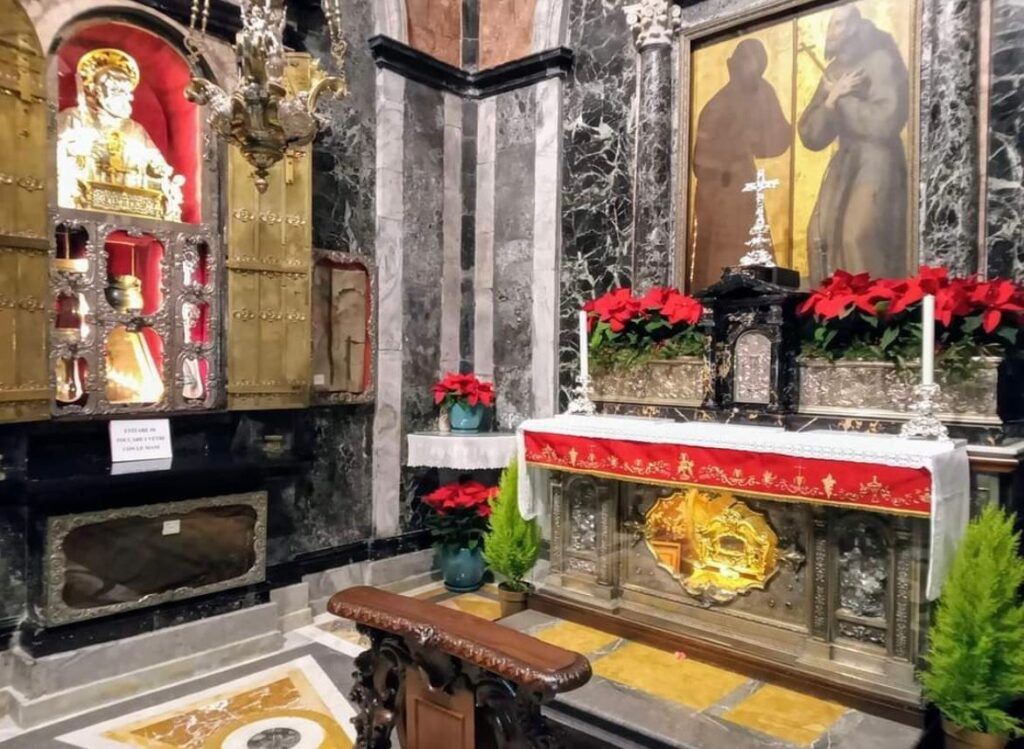It’s not red on the calendar but May 4th is a date clearly imprinted in the memory of the Calabrians because it’s the day when we celebrate San Francesco di Paola. Although the official liturgical feast is April 2 (on the occasion of his birth), popular and cultural tradition has made the first days of May an unmissable anniversary for devotees in memory of that May 4, 1519 when Pope Leo Paola Santo, twelve years after her death.
Thus, the memory of the canonization has become an opportunity to participate in solemn masses, carry the statue of the Saint in procession, share joy and lightheartedness among the stalls at the fair or among the crowds singing at concerts organized by the municipalities. It happens in many small towns but it especially happens in Paola, the town on the Tyrrhenian coast of Cosenza which was the birthplace of the poor man from Calabria.
The Sanctuary, between sacred and familiar
In our area, devotion to San Francesco di Paola is not just a question of faith, but represents a true identity trait. The hermit saint, born in Paola (CS), is considered the protector of the region and embodies his deepest values: tenacity, humility and love for nature. The Sanctuary is a destination for pilgrims from all over the world who come here to learn about the history of the Saint, see the relics, breathe in the footsteps of his life so rich in wonders and legends that it has inspired works of art, literature and theatre, making it a character loved by generations of Calabrians. What happens when you cross the threshold of the Sanctuary is precisely this: you enter a sacred and familiar dimension, supernatural but tangible.
Anyone who has always rested their head on the “miracle stone” knows this, testimony to when the Saint shouted “stop” at the boulder as it rolled down a slope, preventing it from falling to the ground; those who have always drunk the blessed water that flows from a small rock to the same “spoon” passing it from hand to hand, from believer to believer; those who have always passed in front of the cave in memory of the little lamb Martinello, the friar’s faithful companion, resurrected from the embers of a furnace in which certain starving workers had killed him; who has always remained enchanted and with his nose turned upwards in the historic basilica of Santa Maria degli Angeli which houses his relics.
Food to purify the soul
However, there is an aspect of the life of the founder of the Order of the Minims that not everyone knows and concerns the relationship with food and the emphasis on a diet so simple and frugal as to inspire the diet that will later be called “very lean” . Vegetables, legumes, fruit and bread, with fish occasionally permitted. No to meat, dairy products, derivatives and excessive consumption of wine: in short, sobriety was the watchword because food was seen as nourishment for the body, not as a source of pleasure or indulgence.


It is obviously a question of attributing a religious value to the table because the diet was closely linked to faith and the search for an ascetic life and communion with God. Fasting and abstention from certain foods, then, were seen as means to purify body and spirit. Among other things, although Saint Francis of Paola was not directly involved in the production of wine or food, his philosophy had a profound impact on the food culture of the various communities he touched, promoting values of simplicity, moderation and respect for nature.
Testimony of devotion
What, then, is skinny skinny? We are talking about the “Cucina di Strissimo Magro” of Father Gaspare delle Piane, a Franciscan friar originally from Genoa who lived between 1829 and 1908. Deeply devoted to Saint Francis of Paola, he followed his teachings and adopted his austere and penitent lifestyle . Published in 1880, the book reflects this devotion through the collection of over 470 recipes designed for those who wish to follow a dietary regime in line with the principles of the Saint of Paola. In his work, Father Gaspare delle Piane not only codifies vegetarian recipes but exalts their benefits for health and the spirit: his preparations based on vegetables, legumes, fruit and cereals offered a tasty and nutritious alternative to the traditional diet of period, often rich in meat and fat (hence, by contrast, very lean).

The influence of San Francesco di Paola on “Cucina distrissimo magro” goes beyond simple inspiration: the book itself is dedicated to the Calabrian saint and many dishes include references to his life and teachings. It means that the collection represents a testimony of Father Gaspare delle Piane’s devotion towards San Francesco di Paola but also a precious insight into the food and religious culture of 19th century Italy.


Even today, in fact, it continues to be a resource appreciated by vegetarians, vegans and scholars of culinary history. The relevance of the message of Saint Francis, then, is evident: in the world of food consumerism, the invitation to respect nature and – in a broad sense – for one’s body are a precious warning because food is not just nourishment but instrument of physical and spiritual well-being. Then, as in every aspect of life, the secret ingredient is essential because “everything is for love and nothing is by force” (St. Francis of Paola). (Rachele Grandinetti)











